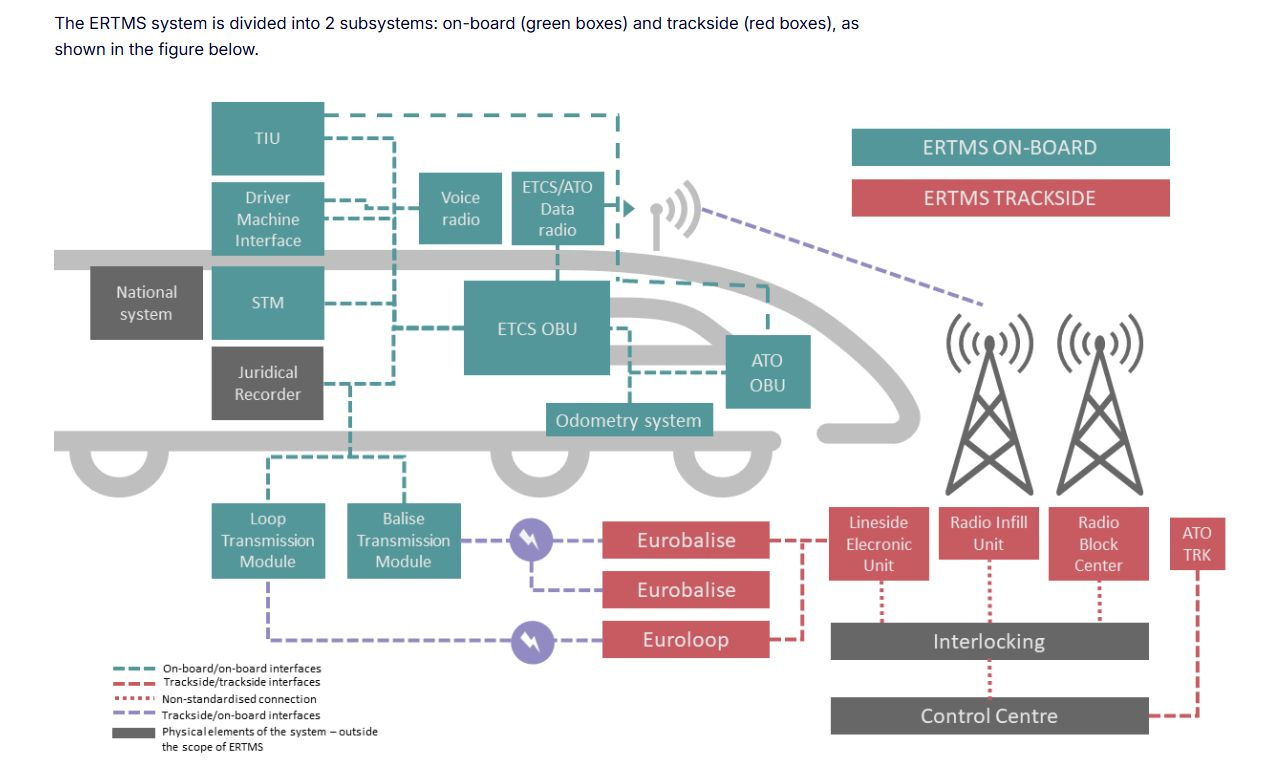How ERTMS works – for those who want to understand it, not build it

ERTMS is Europe’s common digital train-control system. It integrates on-board supervision, radio communication and trackside logic in one standard architecture to improve safety, reduce national divergence and support higher-capacity cross-border operations.
The system is built around three layers: the ETCS on-board unit that supervises speed and movement; the radio system — today GSM-R, tomorrow FRMCS — that links train and ground; and the trackside elements that calculate and transmit movement authority.
ERTMS replaces multiple legacy technologies and provides a shared technical baseline for modern signalling.
The three layers of ERTMS
The ETCS on-board unit continuously monitors speed, braking curves and position. It receives the digital movement authority and ensures the train stays within permitted limits. If limits are exceeded, ETCS applies the brakes automatically.
The radio layer carries messages between train and control. GSM-R is the current platform; FRMCS will replace it later in the decade with greater data capacity and support for automation. The radio link connects the ETCS OBU with the Radio Block Centre (RBC).
Trackside, balises confirm the train’s position, the interlocking sets and protects routes, and the RBC calculates safe movement authority in real time. Keeping route-setting and supervision separate enables Level 2 operation without lineside signals.
How movement authority works
Movement authority is the digital permission to move. The RBC determines how far the train may proceed based on route status and other traffic. The train reports its position at regular intervals. As blocks ahead clear, the RBC updates the authority and extends the permitted distance.
Because braking curves and speed are supervised continuously on board, drivers follow cab indications rather than lineside signals on Level 2 routes. This supports steady operation in all visibility conditions and reduces reliance on national colour-light systems.
Where ERTMS is deployed today
Around 15 000 km of European lines use ETCS on both conventional and high-speed networks.
Switzerland operates nationwide ETCS Level 1 Limited Supervision and uses Level 2 on high-capacity routes, including the Gotthard and Lötschberg base tunnels. Belgium and the Netherlands have advanced corridor coverage.
Spain and Italy use ETCS extensively on their high-speed networks. Poland is equipping its TEN-T corridors. Germany follows a corridor-first strategy on Rhine–Alpine and Rhine–Danube.
Denmark is the first country to replace its entire legacy signalling system with ETCS Level 2, with most lines scheduled for completion by 2030.
Progress varies by network age, complexity and traffic density. Upgrades on busy routes require long-planned possessions, and national funding cycles and procurement capacity also influence timelines.
The 2030 timeline — and what it changes
The EU requires upgraded core TEN-T sections to use ERTMS as the primary control system by 2030. This applies mainly to the busiest international corridors.
The deadline also influences procurement. Renewals in the late 2020s typically specify ETCS-ready equipment and prepare for FRMCS migration.
More consistent deployment — particularly in levels and radio systems — reduces approval complexity and simplifies long-distance freight and passenger operations.
From GSM-R to FRMCS: the next radio system
GSM-R has supported rail communication since the 1990s, but its bandwidth is limited and equipment is nearing end of life.
FRMCS — based on 4G/5G standards — is the successor. Early tests are underway, and wider deployment is expected after 2030 in line with national migration plans.
Higher data capacity makes FRMCS central to automation, shorter headways and real-time diagnostics.
Why it matters: A common signalling standard reduces cross-border barriers and long-term maintenance needs.
What’s next: Migration from GSM-R to FRMCS will define the next phase of ERTMS deployment.
Timeline: By 2030, upgraded TEN-T core corridors must use ERTMS as the primary control system.
Key terms:
ERTMS: European Rail Traffic Management System. EU’s standard signalling architecture combining ETCS, radio communication and trackside supervision.
ETCS: European Train Control System. Supervises speed, braking curves and movement authority on board.
OBU: On-Board Unit. ETCS computer installed on the train that supervises speed, braking curves and position.
RBC: Radio Block Centre. Calculates safe distance and sends movement authority to trains.
GSM-R: Current 2G-based rail radio system for train–ground communication.
FRMCS: Future 4G/5G-based rail radio platform replacing GSM-R and supporting higher data needs.
TEN-T: EU’s trans-European transport network. Core corridors must use ERTMS on upgraded sections by 2030.

